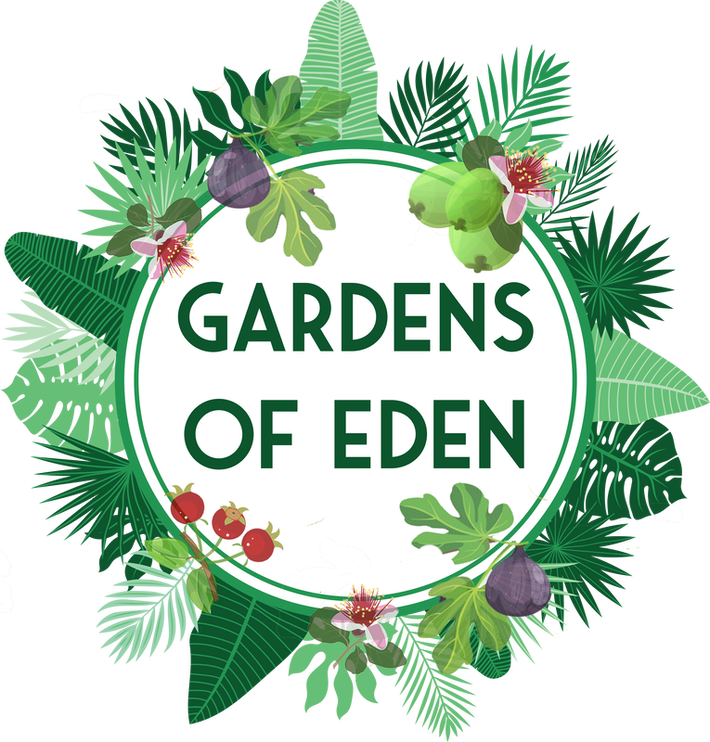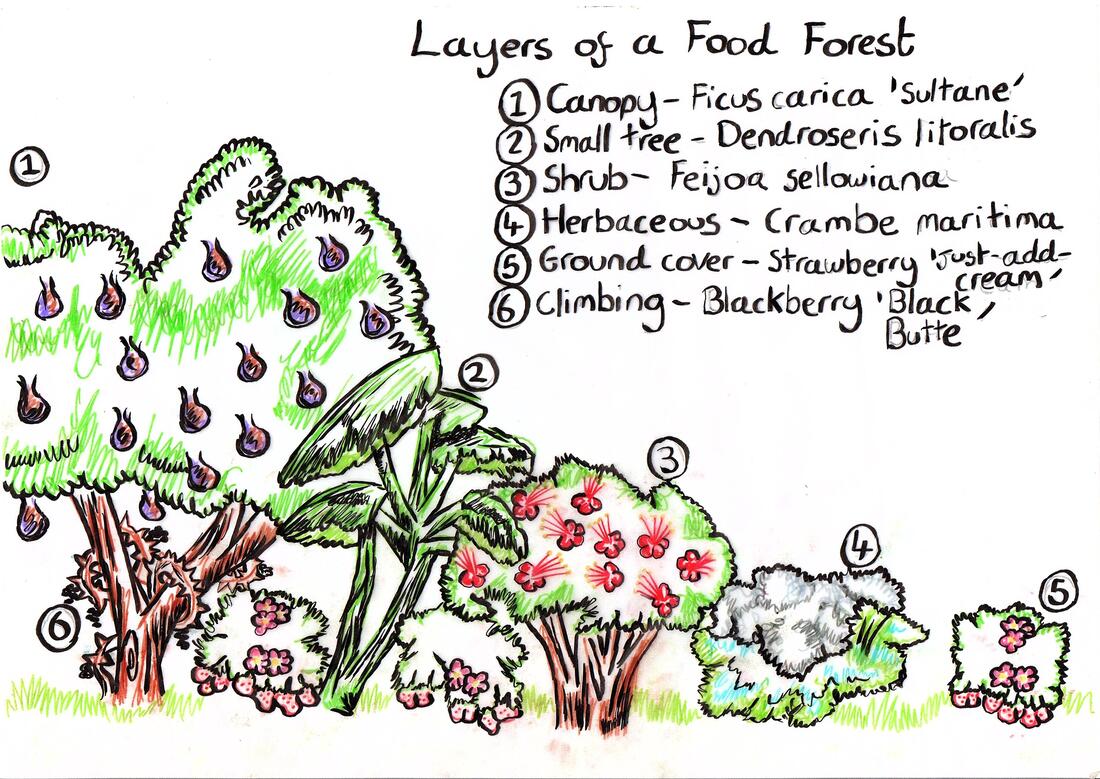|
The first time I heard about the concept of a food forest or edible forest garden, I was already half way through a horticulture degree. Both fascinated by the idea and disappointed that I had only just discovered that such a thing even exists, I immediately began researching what a Food Forest was and, more importantly, how I could acquire one of my own.
A food forest is a permaculture idea and can be designed and created by using the concept of ‘Edible Forest Gardening.’ This method replicates natural forest ecosystems by categorising different plants and their habits into 7 different ‘layers’. Each of these layers fulfils a particular role based on the habit and form of the plant, layers such as: canopy, climber and ground cover. Edible and utilitarian plants are categorised into these roles and then added into a food forest planting scheme. The idea? That the plants will grow together and support each other, trees will provide support for the climbers, groundcover will cover the soil and supress weeds, deciduous trees will drop their leaves mulching the soil… its basically what I would envisage a garden of Eden to have been. What an innovative proposition, nature knows best, lets let natures principles govern the food growing process. At this stage during my education I was already pretty obsessed with exotic food crops, plants such as; Ugni molinae the Chilean guava, Actinidia arguta the cocktail kiwi, Zingiber mioga the hardy ginger, were all on my ‘to buy’ list as soon as I had access to some land. Imagine my excitement then, the prospect of combining exotic food crops with an ecosystem inspired growing system like an edible forest garden or food forest. A means to grow food that also utilises vertical growing space and thrives with biodiversity. Not to mention that the plants in a food forest are perennial, which means that the planting acts as a permanent food producing asset. I cant help but feel that this was a much more logical means to grow food, less fuss and harmonious with nature and wildlife. Conventionally, most of our fruit and vegetables today are grown on annual crops, plants that live out their life in a year and require re-seeding and re-growing every season. After each plant is harvested the plants are disposed of and the soil is sprayed or dug over and new seeds planted. The tilling of soil is actually an unnatural process, the advanced network of mycelium and microbes beneath the soil is churned up and forced to start over. Whereas in nature these networks of macro and microorganisms would remain undisturbed. Also, tilling causes soil and nutrient run off which can be harmful to the environment and ecosystems. Synthetic fertilizers run of into the water table and soil itself is lost into the wind and water. For example, when synthetic nitrogen runs off into water from agricultural systems it can cause algae to grow disproportionately in bodies of water. This then interferes with aquatic ecosystems as the algae outcompetes other species and covers the surface of the water, depriving organisms of light. Generally, in efficient agricultural systems the grower will grow rows of one species in a field or area, also called a ‘monocrop’ for ease of growing and harvesting. This method is extremely efficient but has significant ecological disadvantages. Monoculture farms are vulnerable to pests and diseases, by planting a whole field of one species we inadvertently create the perfect habitat for pests the crops are susceptible too. Imagine being a cabbage white butterfly, stumbling across an entire field of brassicas, the butterfly is surrounded by habitats and food. If one cabbage gets infected the entire crop is risk. As a result, pesticides and weed killers are commonplace in conventional farms which kill insects and have been linked to cancer and ecological damage. When compared to other forms of planting, monoculture is an ecological desert. It’s fairly useless at providing food and habitats for wildlife, an entire field of one specific cultivar of one crop can only support a limited number of species. When you compare this to a wildflower meadow which would contain hundreds of different beneficial plants, monoculture is far worse at supporting biodiversity. This, for me, is part of the appeal for Food Forest planting systems; by planting Food Forests and moving towards a perennial diet we can alleviate the ecological damage caused by conventional agriculture. Food Forests use perennials, plants are planted once and left alone so these systems eliminate the necessity for tilling and the damage it causes entirely. Also, because a Food Forest contains a diverse range of plants the need for pesticides is reduced dramatically if not completely eradicated. For example, if the perennial kale in a Food Forest planting scheme had been eaten by cabbage white, the gardens crop of perpetual spinach and Caucasian spinach would be unaffected. In addition, by interplanting everything together you can take advantage of companion planting. Alliums for example can be great at deterring pests, plant perennial kale with welsh onion and the onion will help deter cabbage whites. Food Forests also present an opportunity to grow crops and flavours, unavailable anywhere else. I think there is something quite romantic about picking fresh figs, persimmons, and guavas straight from the tree, outside in a UK garden and this is entirely possible with Food Forest planting schemes. Food Forests are also resilient to environmental changes, an established Food Forest isn’t likely to be too affected by droughts or unprecedented cold weather, whereas this could be apocalyptic for a monoculture harvest. This resilience is particularly pertinent now, during a climate crisis. For me it seems like such an obvious transition, a perennial diet, food grown in our gardens and green spaces, making sustainably produced organic food free and accessible to everyone and simultaneously alleviating our dependency on conventional, ecologically destructive means of feeding the population. Food Forests are a win win and can look beautiful too. It’s been 4 years since I first discovered the concept of Food Forest and I am still just as fascinated. I have since graduated, founded Gardens Of Eden and been creating Food Forests and Edible Landscapes for myself and clients for 3 years. The passion has only grown and I hope to pass on as much as I can to others. I believe designing and creating Food Forests and Edible Landscapes could change the world for the better.
0 Comments
|
AuthorZac Harris BSc Horticulture (Garden and Landscape Design) Archives |
|


 RSS Feed
RSS Feed


